
More than simply a lack of tears, dry eye causes various levels and degree of discomfort with symptoms like:
- grittiness
- soreness
- irritation
- pain
- burning
- watering
- redness
- eye fatigue
- vision fluctuation
Eye dryness and related forms of this disease, including Evaporative or Aqueous Deficiency in the tear film and Meibomian Gland Dysfunction can result in injury or damage to the eye surface. Additionally, issues with dry eyes may trigger other vision-related problems or indicate symptoms of an underlying medical condition.
Dry eye and related diseases and conditions are often progressive. Both optometrists and ophthalmologists are working together to evaluate and treat patients that suffer from this very distracting and often painful eye condition. Dry eye is similar to what it sounds like but constitutes a lack of lubrication or moisture in the eyes related to the tear film and production of natural tears or secretion of protective lipids from the meibomian glands. Dryness symptoms can be caused by a variety of factors including meibomian gland dysfunction, incomplete blink, medication side-effects, the natural aging process, allergies, computer use, over the counter cold medicines, contact lens wear, environmental factors and more.
If you suffer from a scratchy, watery, dry or a burning sensation you may be experiencing a form of dry eye. In order to properly diagnose this condition, you should visit one of our dry eye specialists. At your visit, we will conduct a comprehensive exam to determine the severity and root cause of the dryness.
Understanding The Tear Film
It is important to understand the importance of the tear film and how this relates to dryness and related disease and conditions. The tear film is made up of three unique layers: an oily layer, a watery layer, and a mucin layer. Small glands at the perimeter of the eyelid, called Meibomian glands, produce the outer, oily layer of the tear film. The main purpose of this oily layer is to smooth the tear surface and decrease the evaporation of tears. The middle, the watery layer is the largest of the three layers, and it makes up most of what we ordinarily think of as tears. This watery layer is produced by small glands scattered through the conjunctiva, the delicate membrane lining the inside of the eyelid and covering the eyeball, and by the major tear gland, the large lacrimal gland. The innermost layer consists of mucus produced by goblet cells in the conjunctiva. This layer allows the watery layer to spread evenly over the surface of the eye and helps the eye to remain quite moist. Without mucus, tears would not stick to the eye.
There are two main forms of the disease: Evaporative and Aqueous deficient.
Evaporative Dry Eye, which accounts for 86% of all dry eye cases is caused by blockages in the Meibomian glands located in your eyelids.
This condition of the obstructed glands is known as Meibomian Gland Dysfunction (MGD). These glands are responsible for creating and secreting the lipid (oil) layer of the tears. When the glands are not working as they should, you don’t have enough tear film oil. And your tears – which lubricate your eyes and keep them comfortable – evaporate too quickly. An insufficient oil layer can cause your tears to evaporate 4x-16x faster, leaving the surface unstable and not properly protected.
Aqueous Deficient Dry Eye occurs when the lacrimal glands do not create a sufficient amount of aqueous (water) to keep the eyes moist.
1-Limp MA, et al. Distribution of aqueous deficient and evaporative dry eye in a clinical-based patient population. Cornea. In press.
What are some of the risk factors for an Evaporative dry eye?
- Hormonal changes in women during menopause – particularly decreasing levels of estrogen – can cause thickening of the oils secreted by the Meibomian glands, which results in blockages.
- Decreased estrogen levels may enhance conditions under which staphylococcal bacteria can proliferate in the Meibomian glands. The result is a decreased oil secretion rate.
- Additional factors that may cause or exacerbate Meibomian Gland Dysfunction include age, contact lens use and hygiene, cosmetic use, and illnesses, particularly diabetes.
- Incomplete blink.

